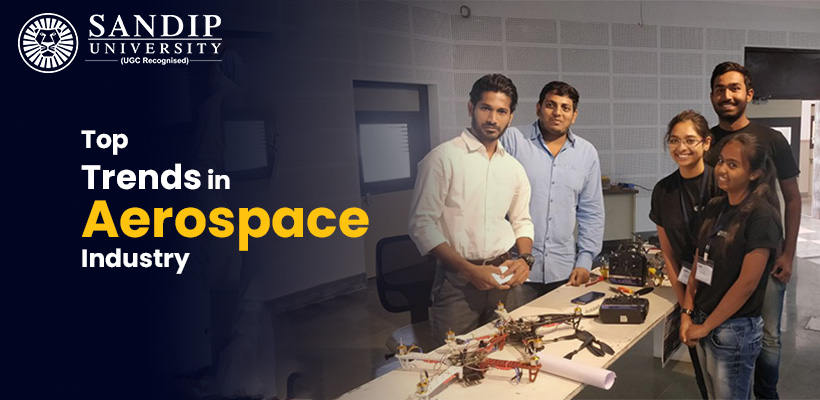The aerospace industry is one of the fastest growing industries today. Every year, several trends emerge in this industry that drive innovation further. These innovations help the industry modernise itself and address current and future challenges.
Technologies like artificial intelligence, 3D printing, deep learning, and machine learning have helped the aerospace industry advance by leaps and bounds. However, there is scope for a lot more development in the field. Let us take a look at what aerospace tech comprises, and the top emerging trends in this industry.
What is Aerospace Technology?
Aerospace technology consists of the designing, testing, manufacturing, and maintaining aspects of aircrafts and space-oriented crafts. Aerospace engineers and technicians are generally involved in creating, operating, and maintaining such systems in the industry.
As air travel, air defence systems, and space exploration are becoming a huge part of government expenditure, there is a need for professionals who can work competently in the industry. So, if you are considering a career in this field, this is the right time to make your move.
Future of Aerospace Industry: Top Emerging Trends
- Environmental Sustainability
Climate change and sustainable growth have become the need of the hour to safeguard the future of humankind. Reducing carbon footprint is a goal that the aerospace industry is trying to obtain with the help of innovative technology. There is a push for sustainable building materials, zero-fuel aircrafts, electric flight technology, and energy-efficient alternatives to safeguard the environment without compromising on human safety. Sustainable technology is going to be at the forefront of development in the aerospace industry.
- Implementation of Digitisation
Digitisation is another technological advancement that is being integrated into the aerospace industry. Digitisation helps in a series of processes such as quicker manufacturing, better supply chain management, more advanced aircraft operational and communication systems, and better data-enabled solutions. Digitisation goes a long way in ensuring that the engineering and manufacturing processes in the aerospace industry are highly optimised to avoid issues regarding efficiency and productivity in the long run.
- Artificial Intelligence and Machine Learning
Artificial intelligence and machine learning have enabled the aerospace industry to automate many repetitive manual processes and eliminate the possibility of human errors. AI helps in ensuring that routes are optimised, assets are utilised effectively, fuel is used efficiently, and time is saved when making critical decisions. AI and ML also helps human pilots avoid errors when manoeuvring an aircraft, and gives them advanced warning about faulty equipment that may need maintenance.
- Smart Satellite Technology
A major part of space-related activities consists of satellite launches. Industry projections show that there is going to be an increase in the number of satellites launched in the future. There has been a decrease in the cost incurred to launch satellites and an increase in demand for geospatial intelligence and satellite imagery. Due to this, public and private sector companies are investing in smart satellite launch technology to boost the number of satellites that launch every year. In 2017, ISRO launched 104 satellites, which was the largest number of satellites launched by any space agency during a single flight.
- Additive Manufacturing
Additive manufacturing, which is more commonly known as 3D printing, is considered to be a revolutionary advancement in the manufacturing sector. 3D printing uses a lesser quantity of materials and is a much faster means of manufacturing anything, making it very efficient and cost-effective. The need of the hour is for the aerospace industry to adopt 3D printing to manufacture various aircrafts, space crafts, spare parts, and equipment needed in industry. This can increase the overall performance of the industry, while also rapidly creating necessary components needed for air travel, space exploration and military defence.
- Structural Health Monitoring
Structural Health Monitoring (SHM) is the technology that observes and monitors various engineering structures like aeroplanes to ensure their safety and efficiency. The main goal of implementing SHM is to avoid aircraft systems failure, and ensure that the aircraft receives timely maintenance. This is an automated and cost-effective method of avoiding loss of life due to aeroplane crashes. There has been significant innovation in the aerospace industry with regards to SHM sensors due to fibre optics and active ultrasonics in the field.
Conclusion
The aerospace industry is thriving and there is going to be massive growth in this field in the future as well. If you want to be a part of a futuristic and challenging industry, then you can consider pursuing a career in aerospace engineering. B.Tech Aerospace Engineering is one of the best aerospace engineering courses that you can pursue to make a career in this field.
Look for top colleges that offer a dynamic industry-relevant curriculum with focus on hands-on skill development, overall student development, and access to industry resources in terms of placements and 100% placement assistance. Such a college can help you become a part of a growth-oriented and global industry. Good luck!

